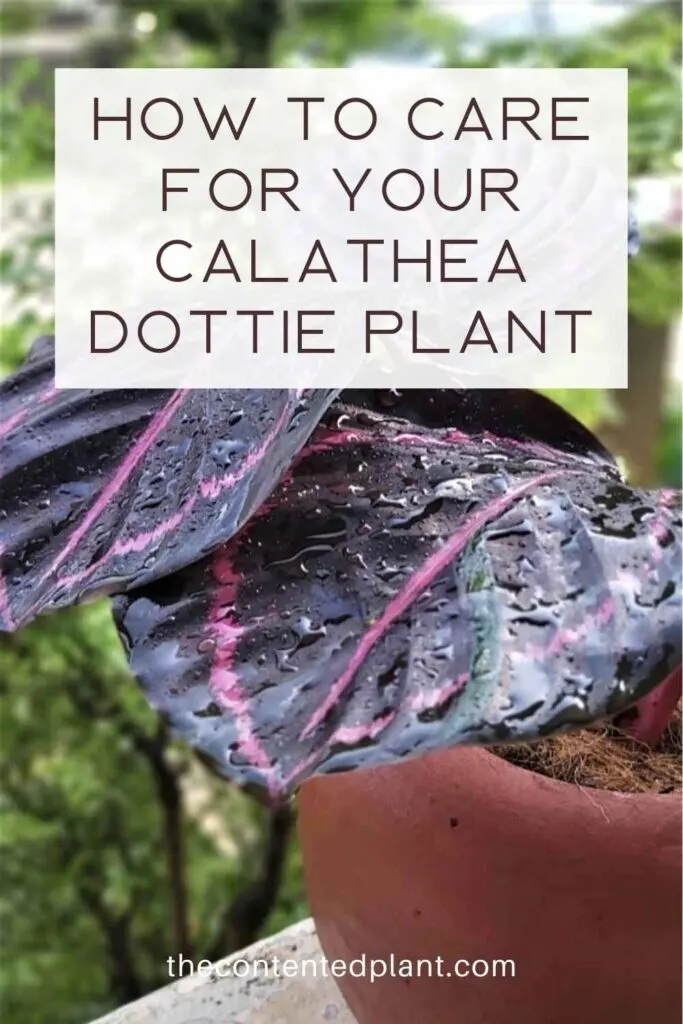Calathea Dottie is a study in the simple and stunning. This Calathea has intensely contrasting color patterns. With very dark leaves (almost black) and a bright pink color pattern that runs up the leaf rib vein and around the leaf perimeter.
This plant gives off a bit of an Emo vibe. Dark, gothic and lots of drama.
Like all prayer plants the Dotties leaves move throughout the day following the light. At night they fold up.
The result is a show stopping plant with eye catching appeal and personality.
The Dottie is one of the easier to please Calatheas. So if you have always wanted to try one… This Calathea might be a great choice for you.
This is a Roseoptica Calathea otherwise known as the rose painted Calatheas. You may think only the Medallion is a Roseoptica. Not so. It is just the most popular. That’s because the Rosy and Dottie are rather new on the Calathea shopping scene. Give them time!
The Roseopticas have recently been reclassified as Goeppertia roseopictas. But you will find them in stores and online most often discussed and sold as calatheas.
They are all very pretty with rounded large leaves. They grow bushy. And get around a foot and half high and round. They make great statement plants in the proper setting.
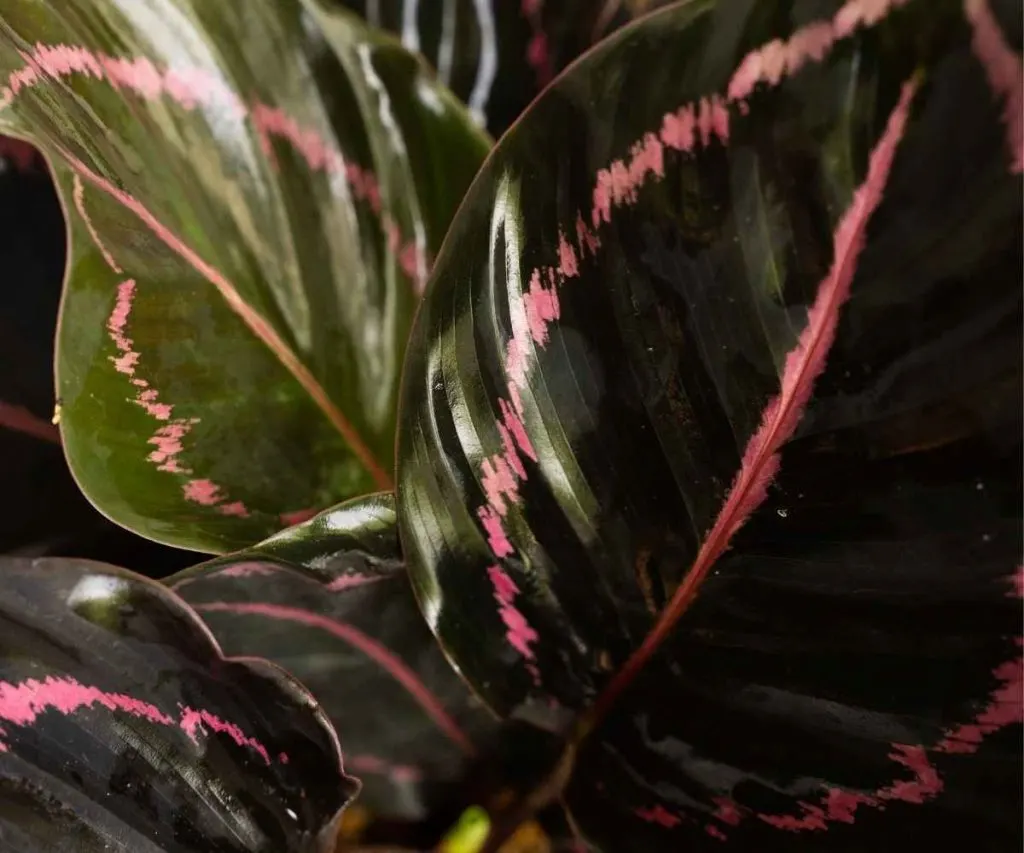
All the Rose painted Calatheas have brilliant markings with at least some Rose accents.
The Dottie stands alone with a deep burgundy leaf that really sets off the rose markings. The underside of its leaves are also a colorful purple.
This Calathea does NOT lose it’s markings. As it matures the bright pink markings will stay strong and lively for you.
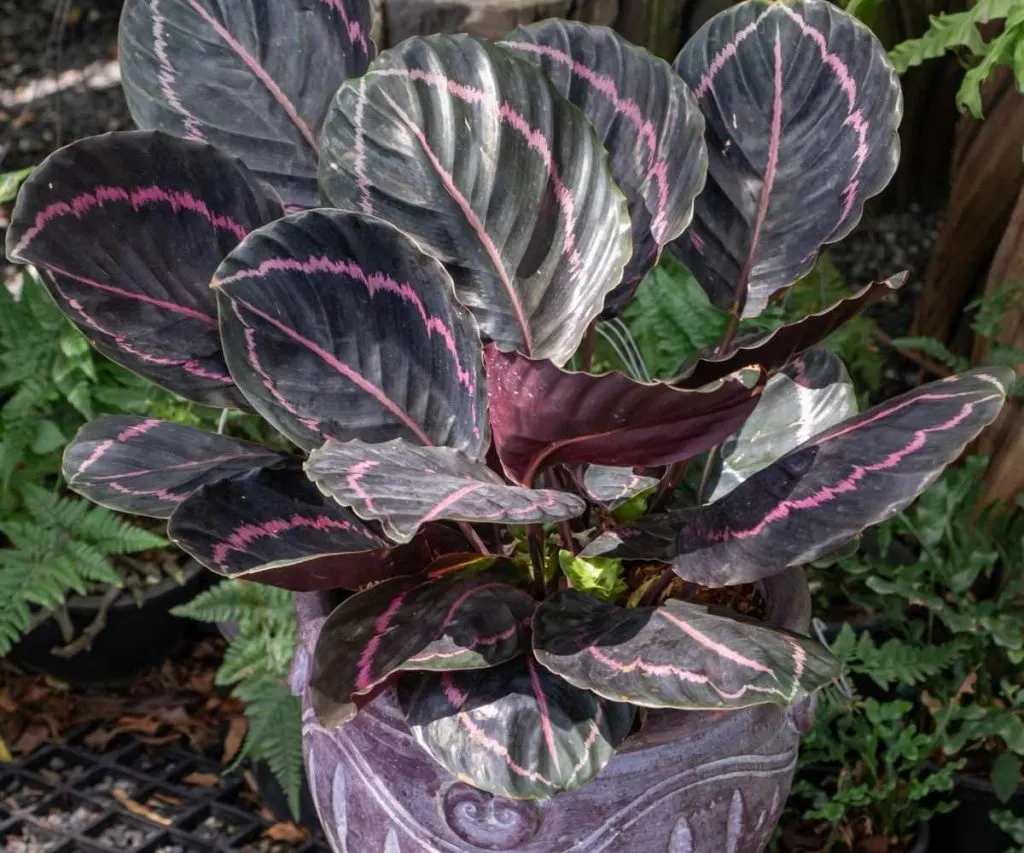
Dottie Plant Profile:
Most Calathea plants grow wild in Brasil in the tropical lowland rainforests.
The Dottie may be easier to grow because this is actually a mutation of the Calathea Roseo Picta. It doesn’t live wild. It’s a commercially cultivated houseplant.
However, It will also do well in tropical climates as an outdoor patio plant.
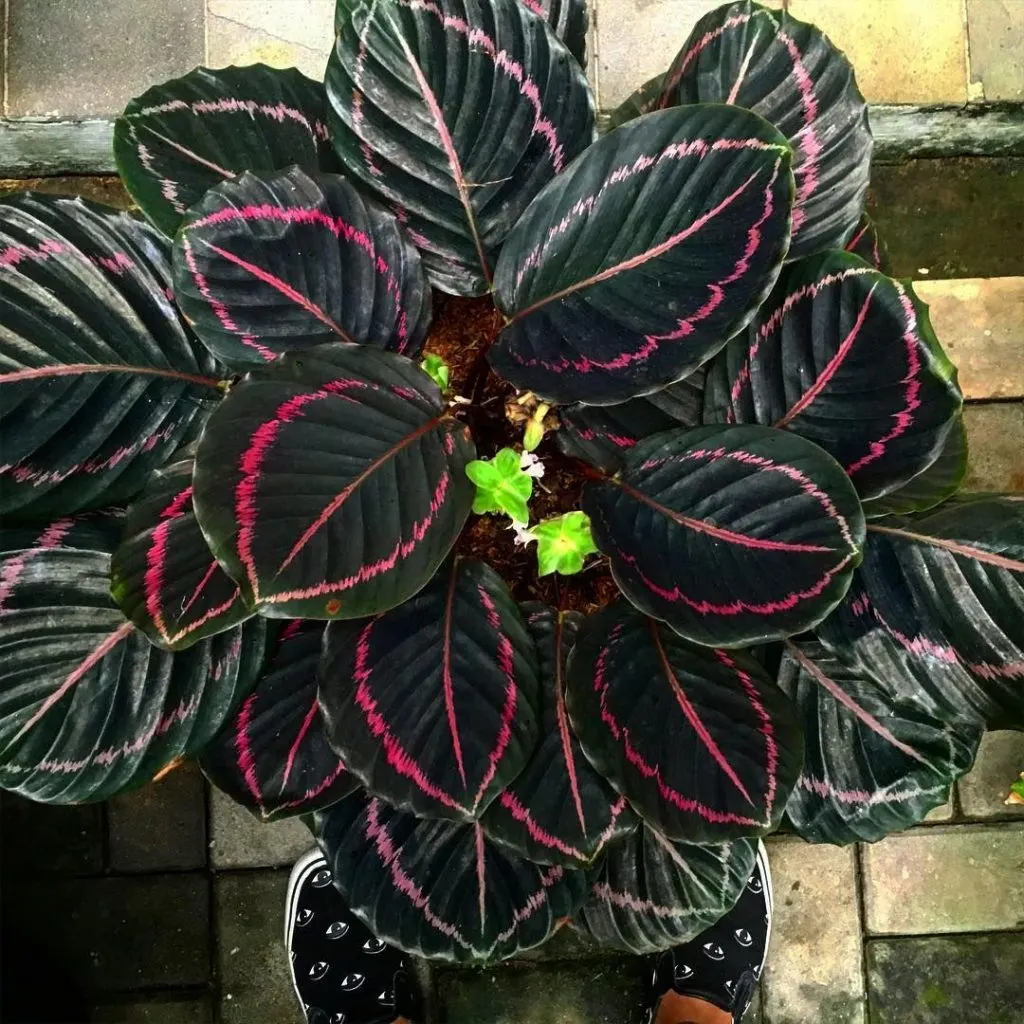
The Dottie has small green flowers that provide a touch of bright contrast to the dark leaves. You may never see the flowers. They don’t grow unless conditions are just right. The flowers are small and easy to miss.
All Calatheas have advantages as house plants. Once you learn how to care for the Dottie she will shine darkly for you year after year.
This plant is a good pick if you have small children or pets. All Calatheas are Pet and Human safe. The Dottie is one of the Best Air Filtering Plants.
And its also a great plant for low light. Just set it in moderate indirect light. Never bright direct light or the leaves will burn.
Calathea Dottie Care Guide:
Learn all you need to know to care for the Calathea Dottie in our care guide below.
Calathea Dottie Care guide
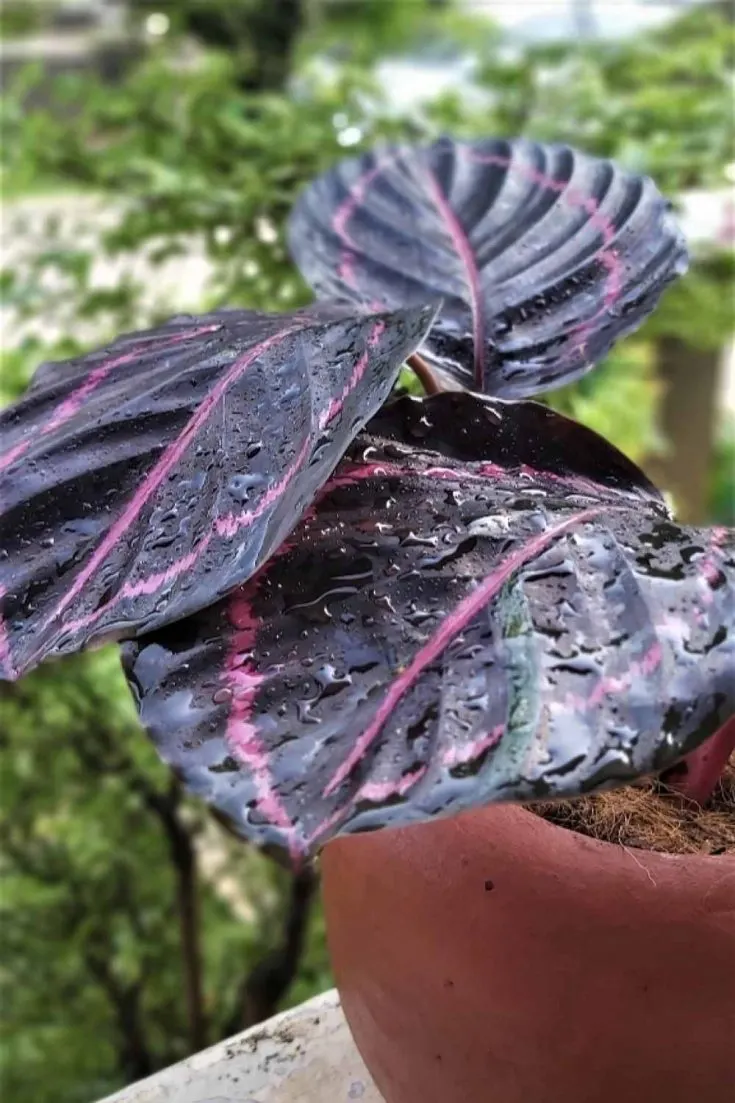
Calathea Dottie Plant is a beautiful plant with a dramatic dark color and eye catching purple pattern in it's leaves. Their care needs are specific and important.
They are sensitive. However, The Dottie is easier to get along with than some of its fussier relatives.
Once you find the perfect growing conditions for your Calathea it will perform well for you.
Learn what they need and give it to them. Their lovely foliage is so worth the effort!
All Calathea plant care is similar. No matter what type you own this care guide will apply.
Materials
Tools
Instructions
Soil Preference:
- Calatheas enjoy a light well draining soil.
- A mix of potting soil and perlite and peat (or Coir ) will keep the roots happy if well mixed with lighter soils.
- Our mix for this plant is 30 % potting mix, 30% succulent soil or coir and 30% perlite or pumas.
- A heavy soil potting mix is not recommended for these plants.
- These plants are also able to grow well in semi Hydroponic systems
Pot Size and Type
- Calatheas grow from rhizomes. And they grow new offshoots to the sides of the mother plant.
- This means they will fill a pot out as a wider plant eventually. Quite a nice table top centerpiece.
- Calathea Beauty Star will grow to the size of the pot with one or more rhizomes. If you leave it to grow as a grouping of rhizomes in one pot you will need to find a pot that has a wider circumference. They do not like to be overly root bound.
- If you want to encourage faster growth choose a pot about 2 inches wider in diameter than the current pot.
- Use a well drained ceramic or plastic pot. It MUST have excellent drainage.
- Terra cotta pots are not recommended. They will wick too much water away from the soil.
- Repot every second year or when roots come out the drainage holes on the pot bottom To the next pot size up.
- Don't jump to a huge pot from a small one unless you wish to encourage faster growth. Just go to the next size up pot. A Too large pot with too much constantly moist soil will encourage root rot.
- For Calatheas a self watering pot system works well. (linked above). They control the watering for you and help avoid root rot, overwatering and under watering.
Lighting:
Calatheas enjoys indirect light for best leaf variegation and optimal growth.
- If the leaves fade move the plant to a less bright area and see if that helps.
- Too much light can also fade the leaves and crisp the leaf edge.
- It will tolerate lower indirect light but the plant may grow more slowly. Leaf variegations may not be well expressed.
- Shield the plant from strong direct light in summer south and west sunny windows. The leaves will burn and the colors will fade. Look for dry brown spots on the leaves and curling brown edges. If you see them move the plant to lower light.
- Tip: Window sheers or blinds can offset some brief periods of high direct light.
Watering:
- Your Calathea is VERY sensitive to the water you use. These plants love low mineral, soft acid water between 5.5 and 6 Ph. Hard water high in minerals and salts will burn the leaves.
- Collect rain water or use Filtered or distilled water to prevent problems with minerals and PH.
- Water your Calathea when the soil is dry down an inch or so. Calatheas enjoy even moisture in the soil. But never let it sit in soaking wet potting mix.
- Be sure to use your moisture meter every couple of days and especially before watering. The dial should read moist when pushed down to the bottom of the root system. If the meter reads dry you need to water. But if it reads wet WAIT. This is important. Calatheas are sensitive and easily get yellowing leaves and root rot. Do not overwater!
- Calathea Dottie enjoys evenly moist soil. However, don't water your plant until your moisture meter tells you the plant is verging on dry in several places in the soil.
Watering Problems:
- If your calathea leaves start to roll up and curl, the plant droops or the edges turn brown suspect watering problems.
- Under watering can show all the symptoms listed above and most often causes leaf edges rolling up, brown tips and crisping. Adjust your watering or soil mix to accommodate.
- Yellowing leaves can also mean the plant roots are too saturated and are starting to die.
- For best practices Try a watering schedule of once a week. But do not water if the soil is wet. Alternately, Do not let the soil dry out completely.
- Watering is best done on a regular schedule with a moisture meter check so the plant is not over or under watered. Both can cause stress.
- These tropical plants enjoy humidity of 50 to 70%. Use a hygrometer next to your calathea to make sure you have enough humidity for them.
- If the soil is compacted, the bottom of the soil can remain wet which encourages, grey mold on the leaves, root rot and Fungus Gnats. If you see yellow leaves or leaf tips you are probably overwatering or Inconsistently watering.
- In dormant winter months reduce watering to when the soil is dry down 2 inches when you stick your finger in the soil. For a moisture meter water when the meter says barely dry..
Humidity Tips:
- Calatheas are happy at 50 to 60% humidity. Although they can tolerate higher, do not let it drop under 40%.
- IF your calathea has brown crispy tips or edges the humidity is probably too low for it.
- I use an inexpensive hygrometer to monitor the room temperature and humidity levels near mine. It is cheap and so helpful!
- In dry climates this plant will thrive with a humidifier nearby. Or set it in your kitchen or bathroom.
- Frequent misting on a regular daily schedule will help keep humidity up when all else fails. However, misted leaves can be hosting spots for bacteria and fungi.
- Set the Calathea plant on a pebble tray with water not touching the pot bottom for added humidity as necessary.
- Grouping plants together will also provide more humid conditions as they respire and evaporate.
- If your calathea leaves show viral or bacterial spots on them your humidity may actually be too high. Try reducing it and keep an eye on the watering. This can also be a sign of unhealthy roots.
How to Fertilize:
- Calatheas require a regular fertilizing schedule. BUT, they are susceptible to fertilizer burn.
- Apply a good quality fertilizer (linked in materials) monthly through Spring and summer at half dose. If you see burn marks on the plant leaves reduce fertilizer by half again.
- Decrease feedings by late Fall and allow your Network plant to rest through the winter months.
- Look for brown spots on the leaves of your plants. This may indicate an over concentration of salts in the roots from over feeding. It can burn the leaves.
- The remedy is to set the plant under a faucet of water and let the water run through for 10 minutes or so. Allow the pot to Completely drain. Discontinue fertilizer until the plant recovers.
Temperature:
- Optimal temperatures for Calathea plants are 65 degrees F. to 75 degrees F.
- Calatheas are sensitive to cold drafts from windows and doors.
- In winter, beware heat vents blowing on your plant leaves. Calatheas cannot tolerate uneven heating, or drying heat vents or drafts.
Pruning and Training:
- Sharp sterile Hand pruners or sharp scissors are preferred for pruning. They will give a clean cut that will heal quickly.
- Pruning is usually done to shape the plant or cut off unsightly leaves.
- Calatheas grow wider rather than taller with time. The beauty star calathea grows to about 24 to 30 inches high.
Leaf Care: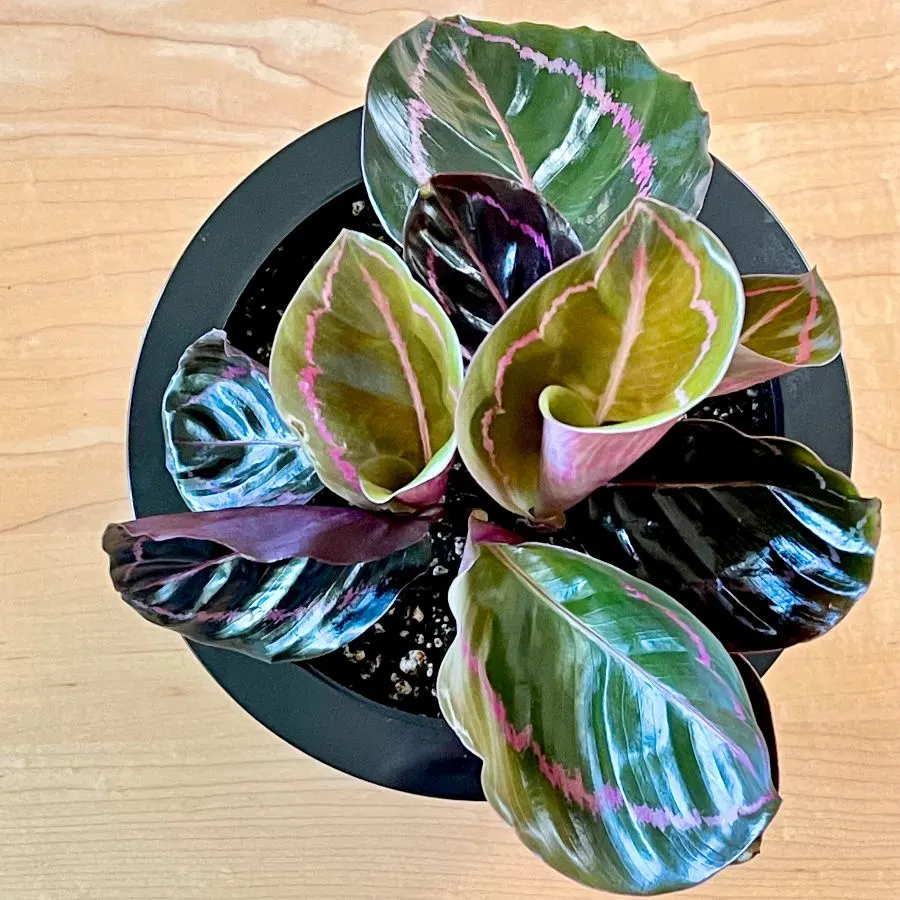
- For the best care your Calathea leaves enjoy occasional washing. By hand. With a damp rag.
- This helps keep the stomata (leaf pores) open for plant respiration.
- Healthy leaves with a good clean surface are most able to resist pests. Neem oil leaf shine and water is a good choice for leaf washing.
- Dusty leaves will starve the plants of water exchange through humidity.
- washing your plant leaves is also a great way to keep pests off the leaves.
- And gives you an opportunity for early pest intervention since you are closely examining your plant.
- Hand Wash the leaves monthly with water and neem oil.
- You can also use a shower to clean off a calathea. Beware the water temperature. Keep it room temperature to avoid shocking the plant.
- If you notice an occasional yellow leaf that droops and fall off the plant this is normal but keep an eye on it. Check for pests, watering issues and how your feeding your plant.
- Read our post on 7 reasons why your plant has yellow leaves for more trouble shooting tips.
Pests:
- All plants get attacked by pests. Calatheas are especially susceptible to spider mites.
- Stress by longterm poor watering practices, poor light, extreme temperatures and soil conditions are contributors to pests. Fungus gnats will set up house in the soggy soil of an overwatered plant.
- Washing the plant leaves occasionally with neem oil leaf shine will help keep pests from establishing themselves on the plant.
- Spider mites are the biggest problem for Calathea plants. Watch for the webs. Treat immediately and continue for two weeks or more to remove the next generation of spider mites after the adults die. Eggs attach to the leaves and cannot be washed off easily.
- Mealy bugs, scale, thrips and whitefly are also common houseplant pests you will see in a stressed Calathea.
- Read our post on How to get rid of aphids and other pests with our homemade pesticide soap recipe or neems oil.
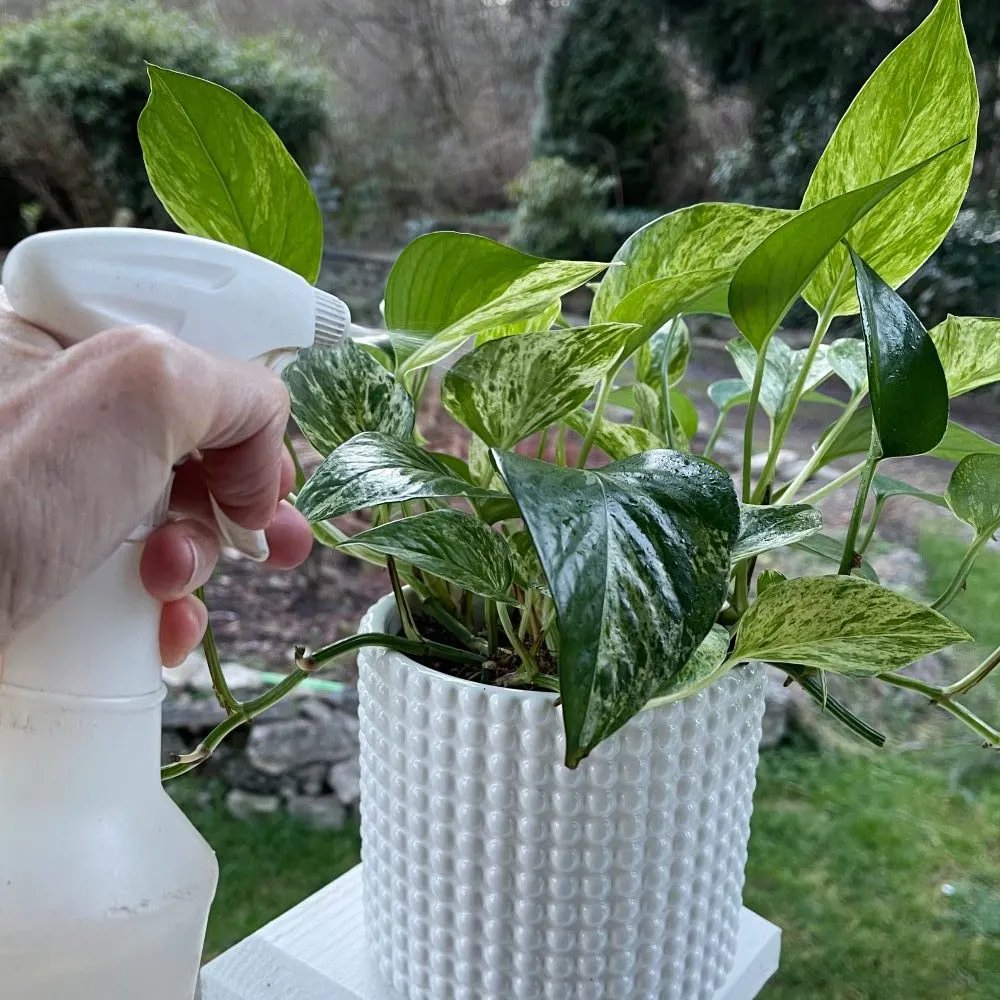
- To minimize the possibility of pests be sure to check all nursery plants before bringing them home. Carefully examine the top and bottom of the leaves.
- Do NOT purchase plants with signs of pest damage or disease.
- Quarantine all new plants until you are sure no pests live in them.
How to Propagate Calatheas:
- Propagation is best done through root division.
- Seed propagation can be done but the seeds can be difficult to source.
- Dividing a calathea is easiest when repotting it in spring or summer.
- Unpot the plant gently. Look at the root system. If the plant is mature you should see a natural parting in the leaves and roots. This is the two plants growing together.
- Each plant section will have its own rhizome. This is going to look like the stem growing straight down with roots coming off them.
- Gently pull apart the two rhizomes to separate them. If the roots are heavily intertwined cut them as necessary with sharp sterile scissors or small pruners.
Pot the two plant sections in separate pots. In 2 to 4 weeks the divisions should be settled and growing.
This is the best time to plant your divided plants into LECA.
Calatheas are air filtering plants.
This means they convert carbon dioxide into oxygen throughout the day and absorb and make nuetral certain toxins common to homes.
Non Toxic Plant:
- All calatheas are non toxic to humans and pets. Still it is not recommended to chew any houseplant.
- Biting or swatting are not good for the health of the plant.
- Also you don't know what chemicals, pests or pathogens are in the soil or fertilizers you use. So best practice is to keep houseplants away from pets and kids.
Notes
The video below is relevant to the care of all calatheas:
Follow Us:
Find us on YouTube, Instagram , Pinterest and TikTok! We love to Plant chat. We also comment, like and occasionally share your content to our daily stories. We’d love to see your plants. Share your joy in your houseplants. Happy Planting!
Recent Posts:
